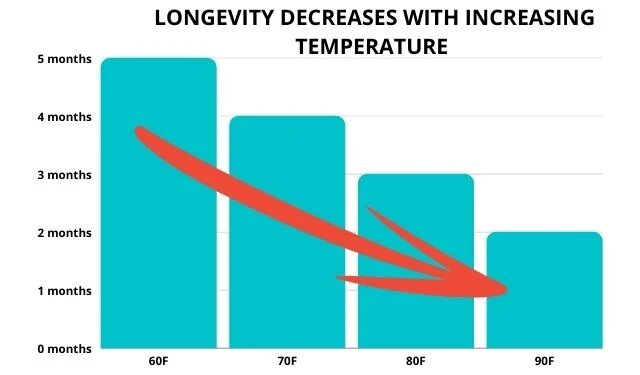Are you noticing small yellow or orange balls in soils? It might be nerve-racking for those newbies who started gardening a few days ago. But in most cases, there is no need to worry.
There is much possibility that those small yellow or orange balls are fertilizer prills like the green type. This might be slowly released from Osmocote fertilizer balls that are used to supplement soil nutrients for a long period of time.
But in a few cases, it can also be eggs of insects, worms, or seasonal frogs. So, how can you understand what orange or yellow balls are you facing in your pot mix? Don’t worry we’ll explain all the facts about and how to solve the problem.
Why Are Small Yellow or Orange Balls in Soil and How to Get Rid of Them?

There are different possible reasons for which, you can see small orange or yellow balls in the soil. Let’s discuss what type of yellow balls you are facing in your potting mix and the way you can deal with them.
1. Fertilizer Balls
Commercial pot mix soil (not garden soil) bought from stores mostly has these yellow balls inside. This may make you wonder whether you have bought a contaminated mixture. But no need to worry they are fertilizer prills.
Most of the selling stores mix those fertilizer prills to keep the soil fertilized for a long time for a maximum of 5 months at 15°C or 60°F temperature. Even in some nursery-grown plants, you will find these yellow prills for strong and better growth.
Here, every granule is coated with unique polymer resin and vegetable oil filled with liquid fertilizer to control nutritional release. For that, the plants will get everything they need to stimulate their growth. Plus, these all-in-one granules will contain major nutrients that are vital for plants. Such as,
- Nitrogen (N)
- Phosphorus (P)
- Potassium (K)
And the formulation of those Osmocote prills contains nutrients driven by the following elements:
- Ammonium Nitrate
- Calcium Fluoride
- Calcium Phosphate
- Potassium Sulphate
- Ammonium Phosphates
However, the formulation can be differentiated according to the needs of plants. Some may even contain micronutrients like manganese and iron for the better growth of plants.
And according to your plants, the slow-release fertilizer balls release the exact amount of chemical nutrients. And unless you add more than the required amount of prills, it won’t harm or badly affect your plants.
Even an excessive amount of synthetic fertilizer balls (not citrous type) can become poisonous for your plants. They can burn your plants, and there is no way to understand whether the fertilizers used are organic or not.
But they are totally harmless for humans or pets unless taken in a large amount. Excess digestion of fertilizer balls will cause severe gastrointestinal problems for both humans and pets. It can cause blue-tinged skin (cyanosis) and muscular weakness, especially in small babies.
Plus, the direct touch of the internal liquid of fertilizer can cause irritation to your eyes and skin. Even breathing in the contents of an uncoated prill can irritate the nose, lungs, and throat. So it’s better to use a mask while working on potting mix soil.
How to Recognize The Yellow Balls Are Fertilizer Prills?
The easy way to recognize fertilizer prills is their size and distinguish hard layers outside. The shapes of these prills are generally spherical that uniformly spread across the potting soil surface. And lastly, they have a dry and hard appearance that you can easily encounter.
But with time the balls can change their appearance from yellow solid balls to clear egg shells. The Osmocote balls absorb water from the soil, dissolve, and pass through the permeable membrane into the soil.
From the data gathered from the data label you see below the hotter the environment gets the faster the prills degrade.

Image Source: flourishingplants.com
However, in total it will take about 2 years to vanish fully. The outer shell takes more time to dissolve than the inner liquid. As the temperature varies the outer shell dissolves, and it releases the inner liquid into the soil for better soil fertilizer and plant growth.
Here the outer coating is made of biomass, CO2, and water which creates the synthetic layer of fertilizer prill, according to the EU controlled-release fertilizer policy. And during the process of dissolving the layer will convert into CO2 gas.
Another reason for fertilizer prills degrading fast is liquid or rain. If you have your pots outside the house will dissolve sooner, than the pots you have inside the home. As the outer shell is hard it will take time to break down, but the inner parts contain a liquid form that needs to come out of the shell to dissolve.
Being a liquid, the inner fertilizer takes less time to vanish. The effect of temperature and soil condition also has a big role there. An Increased amount of rain or water will also speed the process of releasing nutrients from fertilizer balls.
2. Ant Eggs
Another possibility of those yellow eggs can be ant eggs. Ants are all-time guests of pot mix or indoor herbs when you are not careful. As they are attracted to certain types of pests, your pot mix can also turn into ants’ favorite places to stay in.
However, ants mostly find a safe place under the plant for laying eggs far from the scorching sun and external rains. So, if you dig inside the potting soil, you will easily find those little ant eggs.
These eggs will be smaller in size than the fertilizer prills and have a bean shape appearance. In colors, you will see pale yellow or white balls which will be easy to identify for you.
What to Do for Ant Eggs?
Although these eggs don’t do much harm to the plant, they multiply very soon. So, you can find it very disturbing and you’ll see many ants suddenly roaming around your home and garden.
So, to prevent this problem, you can remove those bean-shaped eggs manually from the soil and stop the production of new baby ants in your house garden.
3. Occasional Frog Eggs
Just like the ants, occasional frogs can also lay eggs in your potting mixture. Although they don’t have a strong outer layer, frogs only lay eggs in water to keep up moisture until the eggs hatch.
So, if those frogs lay eggs in your pot, they will look more like clear gel balls with little black dots inside.
What to Do?
Well, they don’t do any harm to pot mix so you don’t have to worry. But if you don’t let them hatch eggs in your garden, don’t let the water flow on your potting mix.
4. Slug/Snail Eggs
Slug or snail eggs have the same size as a fertilizer prill. So, how do you identify them? Well, it has a paler color than the fertilizer balls and has a slimmer appearance. Even in some cases, the eggs can be clear or white in color.
What to Do?
Well in the case of slugs, they are much more harmful than the ant or frog eggs. Snail eggs eat out all the nutrients from plants, soil, and leaf. So, whenever you encounter any snail or slime egg in your pot mix, dig them out manually and place them into the salt mix water to prevent hatching. Or you can also crush them by hand or under your garden boots.
5. Worm Eggs
For eggs, it will be very difficult for you to differentiate as they have the same size, appearance, and color as the fertilizer balls. But if you look more closely, you will notice a little tail or some kind of hair in the worm eggs. Plus, the shape is not exactly spherical, it is more elongated.
What to Do?
Worm eggs are a beneficial creature for your plants so you can allow them to hatch in outside garden soil. And for your safety, you can wear gloves while handling them.
6. Fungus Gnat Eggs
These balls can also be fungus gnat eggs if they have an oval, smooth, and minuscule appearance. Plus, they are generally found hidden in the soil, clumped together with each other so you can differentiate them from fertilizer balls.
How to Prevent It?
Well, for preventing fungus grants from the soil, gardeners use 3% hydrogen peroxide diluted with 4 parts of water. Just spray the mixture into the soil when it’s dry and gnat eggs will thrive down.
7. Vine Weevil, Ladybugs, and Others
If the color is more orangish or deep, the balls are possibly eggs of vine weevil. And the same goes for the ladybug eggs. They have the same orange color and elongated shape as fertilizer balls. But they are fully harmless for your plants.
However, in the case of spiders, it is very rare to see spider eggs in your plants. But they can take shelter in planted herbs and it will be easy to identify you as it has a silky appearance with nets around them.
What to Do?
These orangish balls aren’t harmful, still, if you want, you can remove them manually.
So, What Have We Learned about the Small Yellow or Orange Balls in Soils?
So, to wrap up the whole discussion, it can be said, the possibilities of those yellow or orange balls can be many. Now, the first task for you is to identify what small yellow or orange balls in soils you are facing.
If it has a spherical shape with a hard outer shell and yellow color, then these are fertilizer balls. In some cases, the fertilizer balls can also be blue in color. But if they have a white, pale, or clear color with a slimy texture, then these are some kind of insect eggs laid in your plant soil.
Some of them can be harmful as hell and some may be fully safe for your plants. So you have to identify what eggs are growing on your plant. Well, ant eggs, occasional frog eggs, and worm eggs are totally harmless for your plants.
But in the case of the snail or slug eggs, or fungus gnats, you have to take precautions fast. So, now it’s your time to identify what are you facing in your plants, then take the necessary steps to solve this!

I’m Shofi, a passionate gardener and blogger. I have 10+ years of experience in gardening and hold certifications in horticulture and garden design. I share my knowledge and skills through my garden blog to inspire and educate others on the joys of gardening. I try to provide valuable information and create a community for gardeners of all levels to connect and learn. My ultimate goal is to inspire others to start their own gardens and connect with nature.
